Oregano is a fragrant culinary herb used in many savory dishes worldwide. Whether you’re making a Greek salad or a Mexican-inspired chili, oregano brings depth and flavor to your recipes. But what do you do when you don’t have fresh oregano on hand? Don’t worry! We’ve got you covered with a variety of fresh oregano substitutes that can elevate your dishes to new heights.
Table of Contents
Key Takeaways:
- When fresh oregano is not available, you can use marjoram, basil, parsley, or tarragon as alternatives.
- Mexican oregano offers a unique flavor for Mexican and Latin American dishes.
- Dried oregano is a convenient substitute, but remember to adjust the quantity.
- Experiment with different herb combinations to find your preferred flavor profile.
- Consider growing your own oregano for a sustainable and convenient source.
The Flavor Profile of Oregano and Its Culinary Uses
Oregano has a distinct flavor profile that combines notes of mint, lemon, and earthiness. Its bright and astringent taste adds depth and complexity to a variety of savory dishes. This versatile herb is commonly used as a topping for pizza, but it also plays a prominent role in Mediterranean, Greek, and Mexican cuisines, as well as Latin American recipes such as chili and enchiladas.
The culinary uses of oregano are diverse, making it an essential ingredient in many traditional dishes. Its robust flavor complements the rich flavors of meat and beans, enhancing the overall taste experience. Whether you’re making a pasta sauce, grilling meat, or preparing a vegetable dish, oregano can elevate your recipes to new heights.
When using oregano in your cooking, it’s important to consider the quantity and timing. Adding too much oregano can overpower the other flavors in your dish, so it’s best to start with a small amount and adjust to taste. Additionally, oregano is a dried herb that releases its flavor more slowly than fresh herbs, so it’s generally added earlier in the cooking process to allow its taste to fully develop.
The Versatility of Oregano in Different Cuisines
Oregano is a staple herb in Mediterranean cuisine, where it is commonly used in dishes like Greek salad, roasted vegetables, and grilled meats. Its robust and aromatic flavor adds a Mediterranean flair to these dishes, enhancing the overall taste profile.
In Mexican and Latin American cuisines, oregano is often used in chili recipes, where its earthiness and astringency complement the bold flavors of the spices. It is also a common ingredient in enchilada sauces, salsas, and marinades.
Aside from these specific culinary uses, oregano can also be incorporated into a wide range of other recipes. It pairs well with tomatoes, garlic, onions, and olive oil, making it a versatile herb that can enhance the flavor of soups, stews, marinades, and dressings.
Substitutes for Oregano: Marjoram, Basil, Parsley, and Tarragon
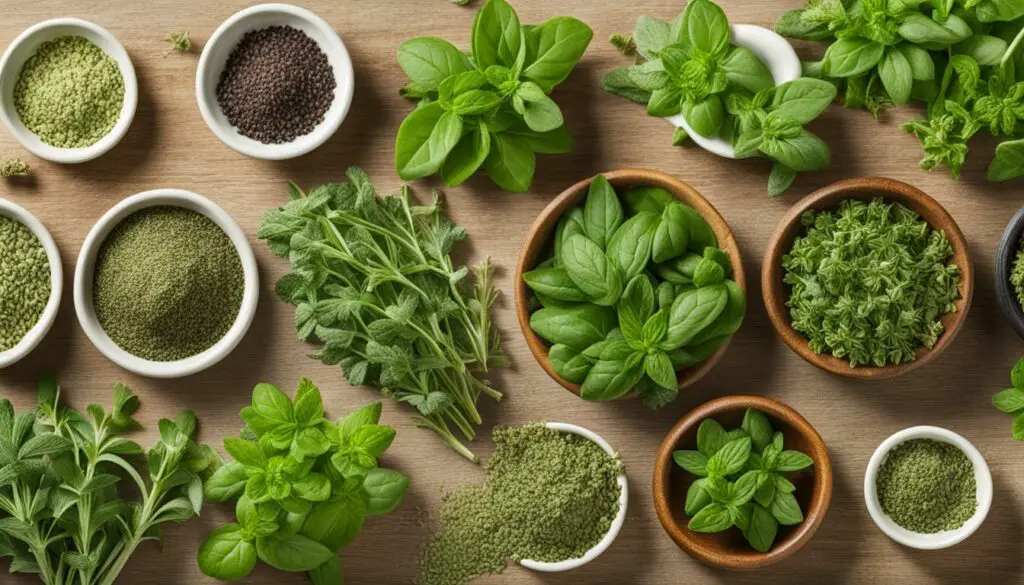
When it comes to finding a substitute for fresh oregano, there are several options to consider. Marjoram is one of the best alternatives, as it is a close relative of oregano and has a similar flavor profile. It can be used in a variety of recipes, from pasta sauces to roasted vegetables. Additionally, basil is another herb that offers a similar taste to oregano. It has a slightly sweeter flavor and is commonly used in Italian cuisine. Whether you’re making pizza or tomato-based sauces, basil can be a great substitute for oregano.
Parsley is also a viable option when looking for an oregano substitute. While it has a milder flavor compared to oregano, it can still add a fresh and herbaceous taste to your dishes. It pairs well with meat, fish, and vegetable dishes, making it a versatile option in the kitchen. Finally, tarragon is another herb that can be used as a substitute for oregano. It has a slightly anise-like flavor and adds a unique twist to dishes. Tarragon works particularly well in French and Mediterranean recipes, enhancing the overall flavor profile.
Each of these oregano substitutes brings its own distinctive taste to recipes, allowing you to experiment and find the perfect flavor combination for your dish. Remember to adjust the quantities based on personal preference and the desired taste outcome. Whether you choose marjoram, basil, parsley, or tarragon, these herbs can provide a flavorful alternative to fresh oregano in a variety of dishes.
Table: Oregano Substitutes
| Oregano Substitute | Flavor Profile | Common Uses |
|---|---|---|
| Marjoram | Similar to oregano | Pasta sauces, roasted vegetables |
| Basil | Slightly sweeter than oregano | Pizza, tomato-based sauces |
| Parsley | Mild and herbaceous | Meat, fish, vegetable dishes |
| Tarragon | Distinctive and anise-like | French, Mediterranean recipes |
Mexican Oregano: A Unique Substitute for Oregano in Mexican and Latin American Dishes
Mexican oregano is a variety of oregano that is native to South America and has a different flavor profile compared to Mediterranean oregano. While both types belong to the mint family, Mexican oregano has a more intense taste with earthy notes. Its distinct flavor makes it an excellent substitute for oregano in Mexican and Latin American dishes.
When it comes to using Mexican oregano as a substitute, one popular dish that comes to mind is chili. The rich and bold taste of Mexican oregano adds depth and authenticity to chili recipes. Its earthiness pairs well with the spices typically found in chili, creating a savory and satisfying flavor profile. If you can’t find Mexican oregano, you can use marjoram or thyme as alternative options.
There are other Mexican and Latin American recipes where Mexican oregano can shine as a substitute for oregano. From enchiladas to mole sauces, Mexican oregano adds a unique touch to these dishes, elevating their flavors to new heights. Its intense taste complements the bold seasonings and spices commonly used in these cuisines, creating a truly authentic culinary experience.
| Dish | Recommended Substitute |
|---|---|
| Chili | Mexican oregano |
| Enchiladas | Mexican oregano |
| Mole sauces | Mexican oregano |
When using Mexican oregano as a substitute, it’s important to consider its more intense flavor. Start with a smaller quantity than what the recipe calls for and adjust to taste. Remember, the goal is to enhance the dish with the unique flavors of Mexican oregano while maintaining a balanced overall taste.
Dried Oregano: The Best Substitute for Fresh Oregano
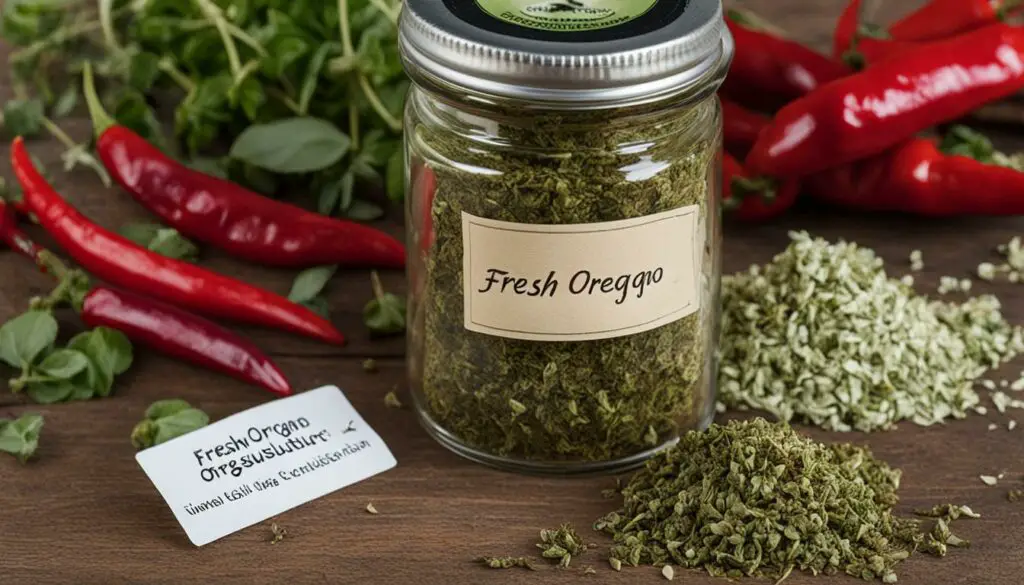
When fresh oregano is not available, dried oregano is the best substitute. Dried oregano has a more concentrated flavor than fresh oregano, so you will need to adjust the quantity accordingly. Use 1 teaspoon of dried oregano for every 1 tablespoon of fresh oregano called for in the recipe. Dried oregano is versatile and can be used in a variety of dishes, including soups, stews, marinades, and sauces. It is also commonly used as a garnish to add a pop of flavor to finished dishes.
To use dried oregano in your cooking, simply crush it slightly before adding it to your dish. This helps release more of its flavor and aroma. Keep in mind that dried oregano can have a stronger taste than fresh oregano, so it’s important to taste and adjust as you go. Start with a smaller amount and add more if desired.
Other alternatives to fresh oregano include fresh marjoram and fresh thyme. These herbs have similar flavor profiles to oregano and can be used interchangeably in many recipes. Experiment with different combinations of herbs to create unique flavor profiles in your cooking.
Comparison of Fresh Oregano and Dried Oregano
| Attribute | Fresh Oregano | Dried Oregano |
|---|---|---|
| Flavor | Subtle, earthy, and slightly minty | Intense, aromatic, and slightly bitter |
| Usage | Best added towards the end of cooking to preserve its delicate flavor | Can be added at the beginning of cooking as it takes longer to release its flavors |
| Quantity | Use 1 tablespoon of fresh oregano for every 1 teaspoon of dried oregano | Use 1 teaspoon of dried oregano for every 1 tablespoon of fresh oregano |
| Storage | Keeps well in the refrigerator for up to 1 week | Can be stored in a cool, dark place for up to 6 months |
Whether you’re making a comforting pasta dish, a flavorful marinade, or a zesty salad dressing, dried oregano is a reliable substitute for fresh oregano. Its concentrated flavor adds depth and complexity to your recipes, making them taste like they were made with fresh herbs. Keep a jar of dried oregano in your pantry, so you’re always prepared to add a burst of flavor to your culinary creations.
Common Questions About Oregano Substitutes

When it comes to oregano substitutes, there are several common questions that arise. Let’s address some of them to help you navigate the world of alternative herbs and spices.
Is oregano the same as Italian seasoning?
No, oregano is not the same as Italian seasoning, although oregano is one of the key ingredients in Italian seasoning. Italian seasoning typically contains a blend of herbs such as oregano, basil, thyme, rosemary, and marjoram. While oregano is a prominent element, Italian seasoning offers a more complex flavor profile that enhances Italian dishes.
What tastes similar to oregano?
Marjoram is the herb that tastes most similar to oregano. In fact, marjoram is often referred to as “sweet oregano” due to its similar flavor profile. It has a slightly milder taste and a sweeter aroma compared to oregano. If you’re looking for a substitute that closely resembles the flavor of oregano, marjoram is your best bet.
Is there a difference between dried oregano and fresh oregano?
Yes, there is a difference between dried oregano and fresh oregano. Dried oregano is more concentrated in flavor compared to fresh oregano, so you will need to use less of it in your recipes. When substituting dried oregano for fresh oregano, use 1 teaspoon of dried oregano for every 1 tablespoon of fresh oregano called for in the recipe. Keep in mind that the texture of dried oregano is different as well, so it may not provide the same visual appeal as fresh oregano when used as a garnish.
Is oregano similar to basil?
While oregano and basil are both aromatic herbs commonly used in cooking, they have different flavor profiles. Oregano has a more robust and earthy taste, while basil has a sweeter and slightly minty flavor. Although they are not interchangeable, oregano and basil can complement each other in certain dishes, especially in Mediterranean cuisine.
| Common Questions About Oregano Substitutes | Answers |
|---|---|
| Is oregano the same as Italian seasoning? | No, oregano is not the same as Italian seasoning, although oregano is one of the key ingredients in Italian seasoning. |
| What tastes similar to oregano? | Marjoram is the herb that tastes most similar to oregano. |
| Is there a difference between dried oregano and fresh oregano? | Yes, there is a difference between dried oregano and fresh oregano. |
| Is oregano similar to basil? | While oregano and basil are both aromatic herbs commonly used in cooking, they have different flavor profiles. |
Using Oregano Substitutes in Recipes
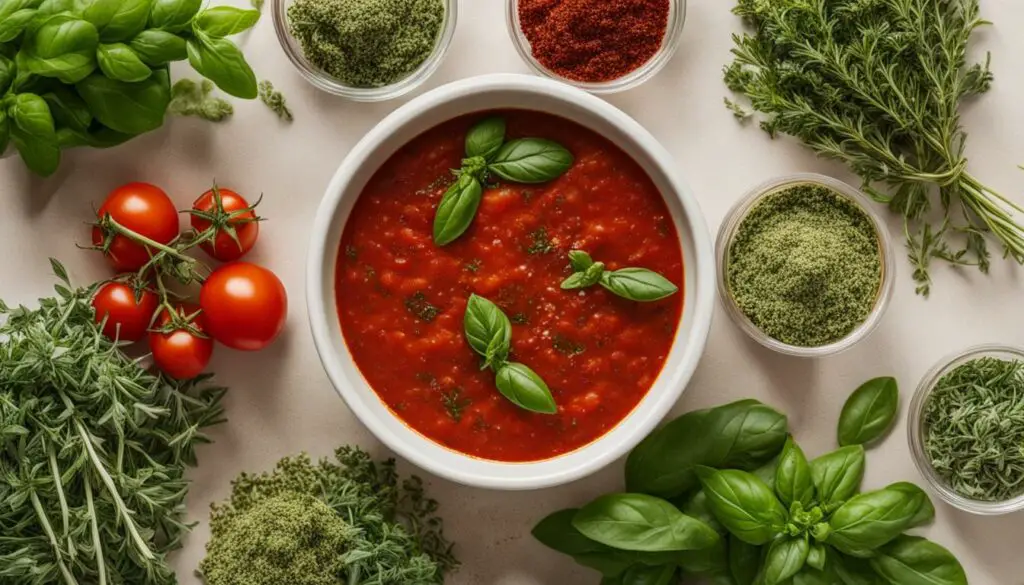
When it comes to cooking with oregano substitutes, there are endless possibilities to explore. The versatility of these herbs allows you to experiment with different flavor profiles and create delicious dishes. Whether you’re making a savory pasta sauce, a hearty chili, or a refreshing salad dressing, oregano substitutes can add depth and complexity to your recipes.
One popular recipe that showcases the use of oregano substitutes is the classic Greek salad. Instead of using fresh oregano, you can try using fresh marjoram or basil to add a similar flavor profile. The aromatic and slightly sweet notes of these herbs complement the other ingredients in the salad and enhance the overall taste. Another option is to use dried oregano, which will provide a more intense flavor.
For those who enjoy Mexican and Latin American flavors, oregano substitutes can be used in dishes like tacos, enchiladas, and salsas. Mexican oregano, with its earthy and intense taste, is a popular choice. However, if you can’t find Mexican oregano, using marjoram or thyme as alternatives can still bring vibrant flavors to your recipes. These substitutes can help you achieve an authentic taste that complements the other ingredients in your dishes.
Recipe Ideas with Oregano Substitutes
- Marjoram-infused tomato sauce for pasta
- Basil and parsley pesto for grilled vegetables
- Mexican-inspired chili with Mexican oregano or thyme
- Green goddess dressing with fresh tarragon
These recipe ideas can inspire you to get creative in the kitchen and explore the world of oregano substitutes. Remember to adjust the quantities of the substitute herbs based on your personal taste preferences and the desired flavor outcome. With a little experimentation, you’ll find the perfect combination of herbs to enhance your favorite dishes.
| Recipe | Ingredients | Instructions |
|---|---|---|
| Marjoram-infused tomato sauce | 1 can of crushed tomatoes, 2 cloves of garlic, 1 tablespoon of olive oil, 1 teaspoon of dried marjoram, salt and pepper to taste |
|
| Basil and parsley pesto | 2 cups of fresh basil leaves, 1 cup of fresh parsley leaves, 1/2 cup of grated Parmesan cheese, 1/3 cup of pine nuts, 2 cloves of garlic, 1/2 cup of olive oil, salt and pepper to taste |
|
“Using oregano substitutes in your recipes allows you to explore new flavors and create unique dishes that suit your taste preferences.” – Chef John Smith
Cooking Tips & Tricks for Using Oregano Substitutes
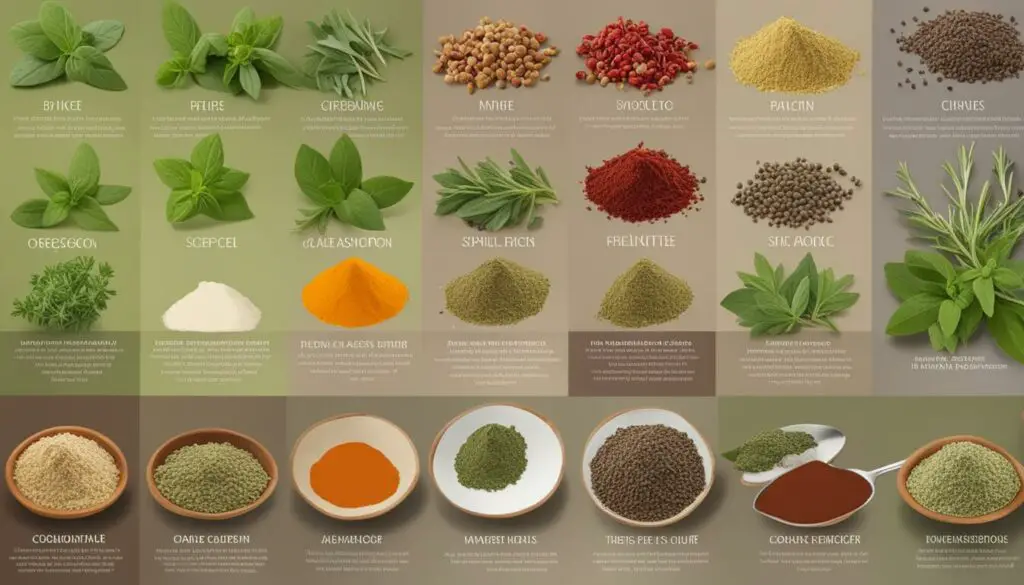
When it comes to using oregano substitutes in your cooking, there are a few tips and tricks that can help you achieve the best results. Whether you’re using dried oregano or other alternative herbs, these cooking techniques will enhance the flavor of your dishes and ensure a delicious outcome.
If you’re using dried oregano as a substitute, it’s important to note that it is more potent than fresh oregano. To release its full flavor, crush the dried oregano slightly before adding it to your recipe. This will help to activate the essential oils and intensify its taste.
“For a more intense flavor, crush dried oregano slightly before adding it to your dish.”
When substituting oregano with other herbs like marjoram, basil, parsley, or tarragon, keep in mind that each herb has its own unique flavor profile. Adjust the quantity of substitute herbs based on personal preference and the desired taste outcome. Be mindful of the other ingredients in your dish and how they will interact with the substitute herb.
To add freshness and visual appeal to your dishes, consider using fresh herbs as a garnish. Sprinkle chopped fresh herbs like basil, parsley, or tarragon on top of your finished dish just before serving. This will enhance the overall flavor and provide a beautiful presentation.
Tips for Using Dried Oregano in Cooking:
- Crush dried oregano slightly before adding it to your dish for a more intense flavor.
- Adjust the quantity of dried oregano based on personal preference and the desired taste outcome.
- Consider the other ingredients in your dish and how they will interact with dried oregano.
- Use fresh herbs as a garnish to add freshness and visual appeal to your dishes.
By following these cooking tips and tricks, you can confidently use oregano substitutes in your recipes and create delicious and flavorful dishes. Experiment with different herb combinations to discover unique flavors that suit your taste preferences. Whether you’re using dried oregano or alternative herbs, these techniques will help you make the most of your culinary creations.
Table: Oregano Substitutes Quick Reference Guide
| Substitute Herb | Flavor Profile | Best Used In |
|---|---|---|
| Marjoram | Similar to oregano with a milder flavor | Pasta sauces, meat dishes, roasted vegetables |
| Basil | Herbaceous and slightly sweet | Italian dishes, salads, soups |
| Parsley | Mild and fresh | Salads, marinades, seafood dishes |
| Tarragon | Anise-like with a hint of bitterness | Chicken dishes, sauces, vinaigrettes |
Benefits of Growing Oregano: A Long-Term Solution
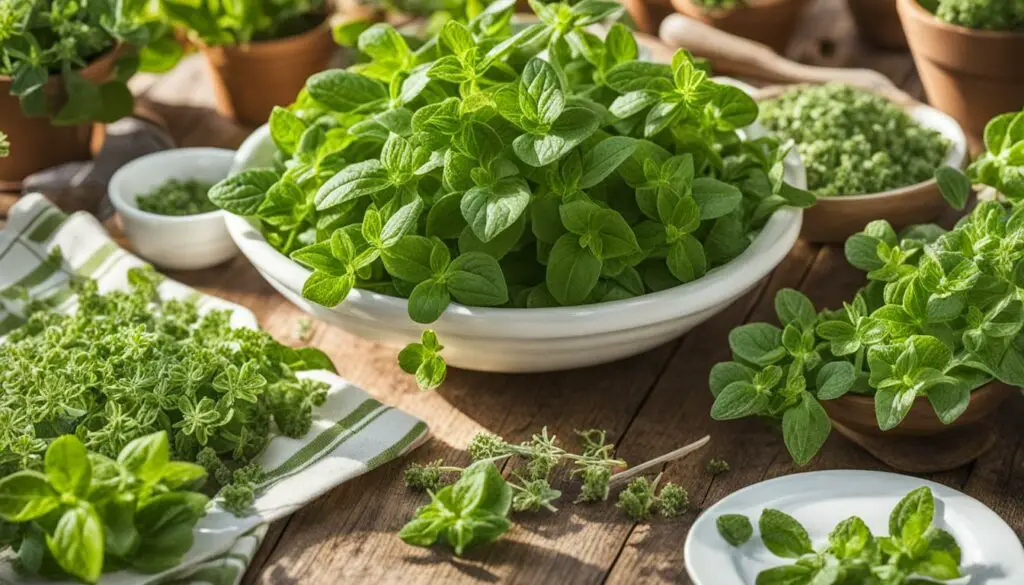
Growing your own oregano not only ensures a convenient and sustainable source of fresh herbs but also offers numerous benefits. Oregano plants are relatively easy to grow and require minimal care, making them ideal for both seasoned gardeners and beginners. By cultivating oregano, you can have access to its aromatic leaves whenever you need them for your culinary creations.
One of the main advantages of growing oregano is the cost-saving aspect. Purchasing fresh oregano from the store can be expensive, especially if you use it frequently in your cooking. By having your own oregano plant, you can significantly reduce your grocery bills and have a constant supply of this versatile herb at your fingertips.
In addition to the financial benefits, growing oregano allows you to have control over the quality and freshness of the herb. You can ensure that your oregano is grown organically, without the use of pesticides or other harmful chemicals. This enhances the flavor and nutritional value of the herb, making it a healthier choice for your dishes.
Another advantage of growing oregano is the joy and satisfaction it brings. Gardening can be a therapeutic and rewarding activity, providing a sense of accomplishment and connection with nature. Watching your oregano plant thrive and flourish can be a source of pride and fulfillment, adding a touch of green to your living space.
The Importance of Oregano in Culinary Delights
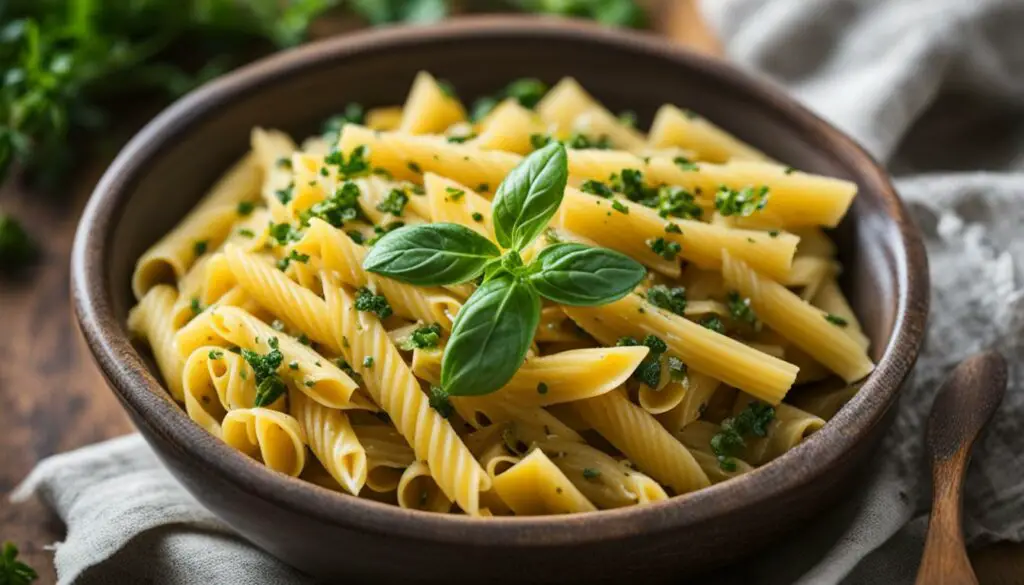
Oregano is an essential herb in the culinary world, adding depth and flavor to a wide range of dishes. Its distinctive taste and aroma elevate the flavors of various cuisines, from Mediterranean to Mexican. Oregano brings joy to the kitchen and enhances the taste of pizzas, pasta sauces, grilled meats, and countless other recipes. Whether you use fresh or dried oregano, its unique flavor profile is key to creating flavorful and delicious dishes.
Known for its bright and astringent taste, oregano adds complexity and balance to savory dishes. Its flavor profile combines notes of mint, lemon, and earthiness, making it a versatile herb that complements an array of ingredients. Oregano is particularly well-suited for Mediterranean dishes, Greek cuisine, and Mexican and Latin American recipes such as chili and enchiladas.
When used in recipes, oregano enhances the overall flavor profile by adding a layer of complexity. It brings a delightful herbaceous and slightly tangy taste that truly enhances the dining experience. Whether sprinkled on top of a pizza, mixed into a tomato sauce, or added to a marinade, oregano is a culinary superstar that adds a vibrant burst of flavor to any dish.
The Many Culinary Uses of Oregano
Oregano is a versatile herb that can be used in a wide range of culinary creations. Here are some popular uses for oregano in the kitchen:
- As a topping for pizzas and pasta dishes
- In marinades for grilled meats and vegetables
- In tomato-based sauces and stews
- In dressings and vinaigrettes for salads
- In herb-infused oils and vinegars
- In spice blends and rubs for roasts and barbecues
- In soups, chili, and beans for added depth of flavor
Flavor Enhancement with Oregano
Oregano is not only beloved for its taste but also for its ability to enhance the flavors of other ingredients. When paired with ingredients like tomatoes, garlic, onions, and olive oil, oregano elevates the overall taste profile of a dish. It adds a layer of complexity and depth that brings out the best in other flavors, creating a harmonious blend of tastes.
Whether used as a primary herb or as a supporting player in a recipe, oregano’s flavor enhancement abilities are unparalleled. It is a versatile herb that can transform a simple dish into a culinary delight.
With its unique taste and ability to elevate the flavors of various cuisines, oregano is a must-have herb in any kitchen. Whether you’re cooking Italian, Greek, Mexican, or any other cuisine, oregano is sure to add that extra touch of flavor that will make your dishes stand out. Get creative with oregano in your recipes and explore the endless possibilities this herb has to offer.
Tips for Substituting Oregano in Your Cooking
When it comes to substituting oregano in your cooking, there are a few tips and tricks that can help you achieve the desired flavors in your dishes. Here are some handy tips to keep in mind:
Start with smaller quantities:
When using a substitute herb for oregano, it’s always a good idea to start with smaller quantities and adjust as needed. Each herb has its own unique flavor profile, so it’s important to taste and adjust accordingly to achieve the desired taste outcome.
Consider the other flavors:
Take into account the other flavors and ingredients in your recipe and how they will interact with the substitute herb. Some herbs may complement certain flavors better than others, so it’s important to consider the overall flavor profile of your dish.
Experiment with combinations:
Don’t be afraid to get creative in the kitchen! Experiment with different combinations of herbs to find your preferred flavor profile. For example, you can try combining marjoram and basil for a more robust flavor, or parsley and tarragon for a lighter and fresher taste.
“Substituting oregano in your cooking is a great way to add variety and explore new flavors. Don’t be afraid to experiment and let your taste buds guide you!”
By following these tips, you can confidently substitute oregano in your cooking and create delicious dishes that suit your taste preferences. Remember, cooking is all about exploring flavors and finding what works best for you!
Conclusion
In conclusion, when you find yourself in need of a fresh oregano substitute, there are several options to choose from. Marjoram, basil, parsley, and tarragon all offer a similar flavor profile to oregano and can be used in various recipes. Mexican oregano provides a unique taste for Mexican and Latin American dishes, while dried oregano is a convenient alternative to fresh oregano that can be used in a variety of dishes.
Whether you decide to grow your own oregano or experiment with different herb combinations, the choice of oregano substitute ultimately depends on personal preference and the specific recipe. Each option brings its own distinct flavor and aroma to your culinary creations, allowing you to continue enjoying the depth and flavor that oregano adds to your dishes.
So, the next time you’re cooking a savory meal and realize you’re out of fresh oregano, don’t worry! With these oregano substitutes at your disposal, you can still achieve delicious and flavorful results. Happy cooking!
FAQ
Is oregano the same as Italian seasoning?
No, although oregano is one of the ingredients in Italian seasoning, they are not the same thing.
What tastes similar to oregano?
Marjoram is the closest herb in taste to oregano.
How much dried oregano should I use as a substitute for fresh oregano?
Use 1 teaspoon of dried oregano for every 1 tablespoon of fresh oregano called for in the recipe.
Is oregano similar to basil?
They are both aromatic herbs but have different tastes.
Source Links
- https://thekitchencommunity.org/different-oregano-substitutes/
- https://scrummylane.com/oregano-substitutes/
- https://www.thespicehouse.com/blogs/news/oregano-substitute
See also:

Leave a Reply